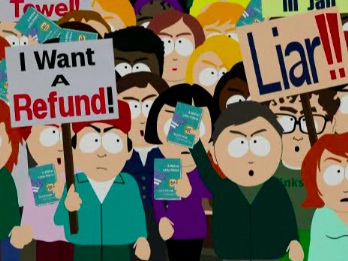
Editor’s note: The following post is a response to our guest series taking a critical look at the daily deals industry. It is written by Vinicius Vacanti, CEO of Yipit, a daily deal aggregator that collects deals from more than 300 daily deal sites.
If you watch the nightly news, you would assume there’s a murder on every block, and if you’ve been reading TechCrunch recently, you would assume Groupon is murdering a small business in every city.
Given the hundreds of thousands of merchants who have run daily deals in the past year, it is inevitable that a few will have had bad experiences. However, to assume that a handful of these anecdotes fully represent merchants’ experiences with daily deals is insufficient and irresponsible.
A series of guest blog posts by Rocky Agrawal criticize daily deals, advising small businesses to stay away based on examples of where the deals fail to turn a profit for the businesses. While Rocky’s posts are surely well-intentioned, his evidence is largely based on a few anecdotes and a basic misunderstanding of daily deal economics.
As we detail in Yipit’s Daily Deal Industry Report based on more than 100,000 past deals, 43% of offers in May involved merchants running a deal for at least their second time. Can so many merchants be delusional? Clearly some merchants have figured it out.
While I understand and applaud Rocky’s motivation to protect small businesses, can those businesses really afford to ignore a marketing channel that can deliver hundreds, if not thousands of new customers in a cost per acquisition model? Not only are most small businesses struggling, their standard marketing channels of yellow pages and newspapers are becoming less and less effective.
Instead of telling small businesses to avoid daily deals, how about trying to understand why some small businesses are having success?
With that understanding, we could then educate other small businesses on how they might be able to replicate that success themselves.
It’s a Numbers Game
Like most marketing options, daily deals comes down to the numbers. The good news is that most of the key variables that affect the success of a daily deal experience can be optimized by small businesses via daily deal structure and execution.
My co-founder, Jim Moran, wrote a post on the economics of a daily deal including a calculator. While this calculator bakes in a lot of assumptions, it’s the start of a handy tool for small businesses.
The two most important variables that small businesses can optimize are:
Overage: This metric represents how much more revenue the customer generates for the business than the value of the coupon. The larger the overage, the better for the small business. There are many things small businesses can do to increase overage including:
- Strategically Price the Offer. If you are running a restaurant and the average per person bill is $30, provide a $15 for $30 certificate. The person is likely to bring someone else turning the meal into a $45 for $60 deal.
- Up-sell the user. In a Hacker News post, this skydiving business does a great job of explaining how they up-sell sky divers into getting videos of their jump (60% of customers) and even a second jump that same day (40% of customers).
Return Rate: This metric represents what percentage of customers come back as a regular customer after using a daily deal. Improving this metric has the potential to deliver the most value for small businesses as indicated by the calculator referenced above. In a report authored by Rice University, often cited as a reason daily deals are challenging, small businesses reported that 20% of customers came back. That’s actually huge! If a company runs a deal that sells 1,000 vouchers, 200 customers will come back. As the calculator above implies, that’s a high enough return rate to make the deals very successful for most small businesses. To improve return rates even further, small businesses can:
- Surprise and delight daily deal customers. Daily deal customers can be a bit embarrassed to be using a deal. Instead of acting disappointed, small businesses should do the opposite and make them feel welcome. They should thank the customers for coming, tell them the story of the business. It’s actually an easy opportunity to surprise the customer.
- Offer an incentive for them to come back. With their bill, offer them a 20% discount or, if you’re a restaurant, a free appetizer to come back and try the business again.
- Collect their contact information. Tell them you often send out notifications for special events and promotions
- Discount just the first session. If you have a business that involves several sessions like class-based businesses, offer a discount on just the first session. If users like the session, they’ll come back for the rest of the sessions paying full price.
Other factors that improve the economics of a daily deal:
- Breakage: Anywhere between 10% and 30% of deals aren’t redeemed. North American businesses get to keep the profits associated with those vouchers without incurring the cost.
- Exposure: Small businesses gets emailed to tens of thousands and, sometimes, hundreds of thousands of users. This exposure is often the entirety of the value provided by most other marketing channels for small businesses.
If small businesses focus on creating the right structure for their daily deal to increase overage and execute on the daily deal experience to increase return rates, daily deals can become a very attractive marketing option.
Not right for everyone
That being said, daily deals in their current form are not right for every business. The vast majority of deals are for spas, salons, restaurants, events, activities and other services. These merchants all have a large fixed cost base, perishable inventory and considerably lower variable costs. Accordingly, their marginal cost on an additional customer is low enough allowing them to discount aggressively. That’s why businesses have been offering discounts for hundreds of years.
On the other hand, traditional retail categories appear the least frequently across the Yipit database, representing less than 10% of all offers.
A powerful tool that shouldn’t be ignored

Daily deals represent a powerful, scalable new cost-per-acquisition marketing channel that small businesses can optimize via strategic pricing and good execution.
If we really want to help small businesses, we should stop telling them to avoid daily deals. Instead, let’s focus our energy on educating small businesses on how they might be able to effectively take advantage of this new marketing channel. Or, I guess we can just keep directing them to yellow pages advertising.